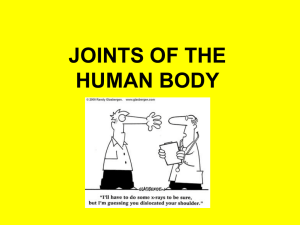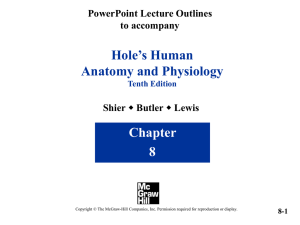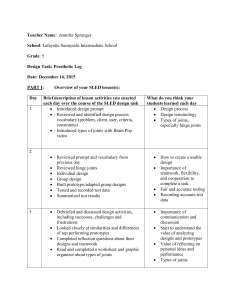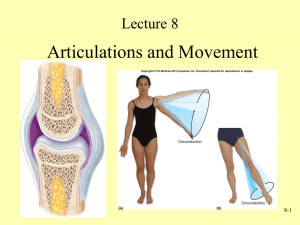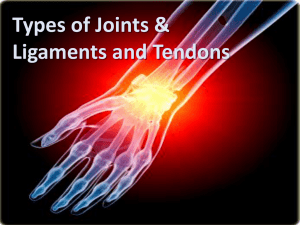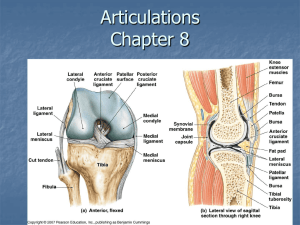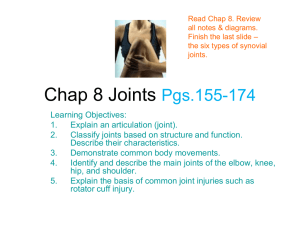Articulations and Movement
advertisement
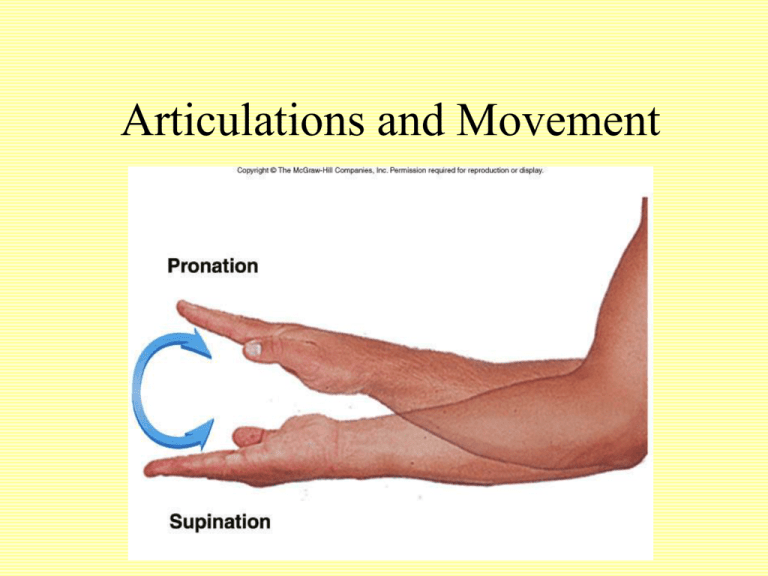
Articulations and Movement Articulations or Joints • Articulation or Joint – Place where two bones come together – Freely movable to limited to no apparent movement – Structure correlated with movement • Named – According to bones or parts united at joint – According to only one of articulating bones – By Latin equivalent of common name Classes of Joints • Structural: Based on major connective tissue type that binds bones – Fibrous – Cartilaginous – Synovial • Functional: Based on degree of motion – Synarthrosis: Nonmovable – Amphiarthrosis: Slightly movable – Diarthrosis: Freely movable Fibrous Joints • Characteristics – United by fibrous connective tissue – Have no joint cavity – Move little or none • Types – Sutures – Syndesmoses – Gomphoses Syndesmoses • Bones farther apart than suture and joined by ligaments • Some movement may occur Gomphoses • Specialized joints • Pegs that fit into sockets • Inflammations – Gingivitis – Periodontal disease Cartilaginous Joints • Unite two bones by means of cartilage • Types – Synchondroses • Joined by hyaline • Little or no movement – Symphyses • Fibrocartilage uniting two bones Synchondroses Synovial Joints • Most common joints in body • Most mobile joints • Have – Articular surfaces on bone with hyaline cartilage – Completely enclosed joint capsule formed from ligamentous connective tissue – Synovial fluid within capsule lubricates joint – Some have meniscus or articular disc(e.g. knee, jaw joint) Synovial Joints • Allow considerable movement • Most joints that unite bone of appendicular skeleton • Complex – Articular cartilage and disks – Joint cavity and capsule – Synovial membrane and fluid • Bursae – Pockets of synovial fluid – Bursitis Synovial Joint Shape Types • • • • Plane joints--intercarpal joints Hinge joints--elbow,ankle, interj-phalangeal Pivot joints--radio-ulnar joint Condyloid joints (egg into oval)--metacarpophalangeal • Saddle joints--carpo-metacarpal joint of thumb • Ball-and-socket--hip, shoulder The type of joint, in part, determines the range and direction of movement Types of Synovial Joints • • • • • • Plane or gliding Saddle Hinge Pivot Ball-and-socket Ellipsoid Plane and Pivot Joints • Plane or Gliding joints – Monoaxial – Example:Articular processes between vertebrae • Pivot joints – Monoaxial – Example: Articulation between dens of axis and atlas Saddle and Hinge Joints • Saddle Joints – Biaxial – Example: Thumb • Hinge Joints – Monoaxial – Example: elbow, knee Ellipsoid and Ball-and-Socket Joints • Ellipsoid – Modified ball-andsocket – Biaxial – Example: Atlantooccipital joint • Ball-and-socket – Multiaxial – Examples: shoulder and hip joints Also see Fig. 9.3, M&M Types of Movement • Gliding • Angular – Flexion and Extension • Hyperextension • Plantar and Dorsiflexion – Abduction and Adduction • Circular – Rotation – Pronation and Supination – Circumduction Flexion and Extension Dorsiflexion and Plantar Flexion Abduction and Adduction Rotation and Pronation and Supination Circumduction Special Movements • Unique to only one or two joints • Types – – – – Elevation and Depression Protraction and Retraction Opposition and Reposition Inversion and Eversion Elevation and Depression Protraction and Retraction Excursion Opposition and Reposition Inversion and Eversion Range of Motion • Amount of mobility demonstrated at a given joint • Types – Active – Passive • Influenced by – – – – – – – Shape of articular surfaces forming joint Amount and shape of cartilage covering surfaces Strength and location of ligaments and tendons Location of muscles associated with joint Amount of fluid in and around joint Amount of use/disuse of joint Amount of pain in and around joint Temporomandibular Joint • TMJ • Combination plane and ellipsoid joint • TMJ Disorders – Cause most chronic orofacial pain Shoulder Joint Elbow Joint Hip Joint Knee Joint • • • • Modified hinge joint Menisi: Fibrocartilage articular disks Cruciate ligaments: ACL and PCL Collateral ligaments: Fibular and tibial Knee Injuries and Disorders • Football injuries • Bursitis • Chondromalacia – Softening of cartilage • Hemarthrosis: – Acute • “Water on the knee” – Slower accumulation Ankle Joint • Highly modified hinge joint • Ligaments of arch – Hold bones in proper relationship – Transfer weight Effects of Aging on Joints • • • • Tissue repair slows Production of synovial fluid declines Ligaments and tendons become less flexible Decrease in ROM Joint Disorders • Arthritis – Osteoarthritis: Wear and tear – Rheumatoid: Caused by transient infection or autoimmune disease • Joint infections – Lyme disease: Tick vector • Gout – Metabolic disorders of unknown cause (idiopathic)



